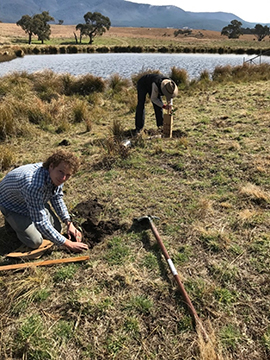Healthy farm dams and riparian areas greatly benefit the properties that host them, and the broader landscape and biodiversity around these properties.
Through the Future Drought Fund’s $7.8 million Natural Resource Management Drought Resilience Program – Landscapes stream, the ACT Government has established a project to assist landholders in reconsidering how they manage their dams and riparian areas.
The ‘Building resilience to drought by establishing drought refuges on ACT farms through improved riparian management and farm dam restoration’ project is rehabilitating 8 farm dams and 5 km of Naas Valley River frontage for interstream erosion control, biodiversity conservation and improvement of water quality and stock health.
The rehabilitated dams are being used to demonstrate to landholders that by enhancing a farm dam, the water retention and quality in that dam can be dramatically improved, and simultaneously turned into a refuge that form part of wildlife corridors across the broader landscape.
The Naas River catchment was chosen as the primary location to demonstrate the positive effects that come from riparian areas restoration.
Brian Butler-Kemp the project manager at the ACT Government, noted that the catchment was chosen due to its history with harsh environmental conditions.
‘The area was hit hard in the drought followed by the fire, then the rainfall.
‘And then it had years and years of typical European farming practices.
‘It's a small area so it is the perfect location to solve a few problems and then to see some direct results,’ Brian said.
John and Carol Lilleyman own 'Amberly', one of the 8 properties involved in the dam restoration project.
Enhancing their farm dams has proved successful for the family, who have cattle and pastured chickens on their property.
The Lilleymans are already enjoying the benefits of improved land health and on-farm biodiversity as a result. John also expects to see healthier livestock when they are reintroduced into the rehabilitated dam paddocks.
‘By doing the work ourselves with volunteers, we were able to tackle 2 dams. Our work for this project included controlling weeds (mainly blackberry and sweet briar) and soft erosion, planting tubestock, fencing off the dam areas to control livestock access, and extending our reticulated water network to provide livestock with an alternative trough water source’, he said.
‘Part of rebuilding the environment around a dam is to allow water to be cleansed by the plants and [other living organisms] in the dam.
‘Turning the dam into a great habitat will attract more species of everything back to the dams. We will improve herd health and, by improving stock health, improve productivity,’ he said.
The project is a successful partnership with landowners, not-for-profit conservation groups, Landcare and citizen scientists.
It is a great example of the benefits that come from leveraging networks of stakeholders to achieve landscape-scale drought resilience.
Find out more about the Amberly Farm Dam Restoration project at Soils for Life.
Read about more of the Future Drought Fund’s Natural Resource Management Drought Resilience Program – Landscapes stream.




